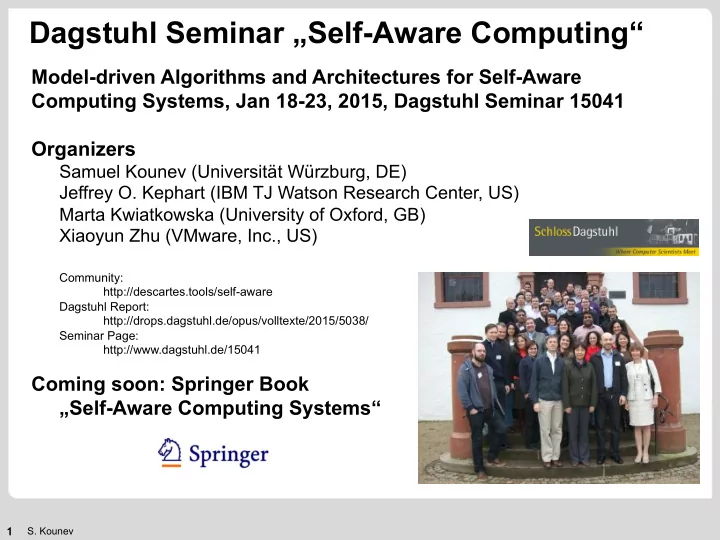

Dagstuhl Seminar „Self-Aware Computing“ Model-driven Algorithms and Architectures for Self-Aware Computing Systems, Jan 18-23, 2015, Dagstuhl Seminar 15041 Organizers Samuel Kounev (Universität Würzburg, DE) Jeffrey O. Kephart (IBM TJ Watson Research Center, US) Marta Kwiatkowska (University of Oxford, GB) Xiaoyun Zhu (VMware, Inc., US) Community: http://descartes.tools/self-aware Dagstuhl Report: http://drops.dagstuhl.de/opus/volltexte/2015/5038/ Seminar Page: http://www.dagstuhl.de/15041 Coming soon: Springer Book „Self-Aware Computing Systems“ 1 1 S. Kounev
Definition Self-aware Computing Systems are computing systems that: 1. learn models capturing knowledge about themselves and their environment on an ongoing basis and 2. reason using the models enabling them to act based on their knowledge and reasoning in accordance with higher-level goals , which may also be subject to change. S. Kounev, X. Zhu, J. O. Kephart and M. Kwiatkowska, editors. Model-driven Algorithms and Architectures for Self-Aware Computing Systems (Dagstuhl Seminar 15041). Dagstuhl Reports, vol. 5, No. 1. pp. 164-196, Dagstuhl, Germany, 2015. http://drops.dagstuhl.de/opus/volltexte/2015/5038 Community page: http://descartes.tools/self-aware 2 2 S. Kounev
Examples of Models ● ● ● ● ● ● Response Time (ms) 15 ● ● <<FineGrainedBehavior>> ● ● IGateway.predict() ● ● ● ● ● ● 10 ● ● <<InternalAction>> ● ● ● <<BranchAction>> ● ● ● ● ● parsePredictionJobs doLoadBalancing ● ● ● ● ● ● ● ● ● ● ● ● ● ● ● 5 ● ● ● ● ● ● Probability: 0.5 ● ● ● ● ● ● ● Probability: 0.5 ● ● <<InternalAction>> ● ● ● ● ● ● ● ● 100 ● ● schedulePredictionJobs ● ● ● ● ● ● 80 ● ● ● ● ● ● ● ● s s t ● 60 e 60 ● ● u <<ExternalCallAction>> <<ExternalCallAction>> ● ● ● q ● ● e R ● ● <<ParametricResourceDemand>> s u PredictionServerA.predict PredictionServerB.predict ● ● 40 o R 40 ● e ● ● ● n ResourceType="CPU" e a q t u ● u l ● m e Unit="CpuCycles" s ● ● S i t 20 S 20 i z Specfication="(0.5506 + (7.943 * 10^(-8) e ( K B * recordsize)) * 2700" ) 0 0 <<implements>> IGateway train() Load forecasting models Statistical regression models predict() <<DataCenter>> results() BYDC <<ComputingInfrastructure>> <<ComputingInfrastructure>> desc1 desc2 Gateway Server <<ConfigurationSpecification>> ResourceType="CPU" <<UsageProfile>> ProcessingRate=2.7GHz UserPopulation=10 Cores=2 ThinkTime=0.0 Production Line Stations Service="train" 1 Gbit Ethernet L RecordSize=500,000 p 7 Application Server Cluster <<ComputingInfrastructure>> <<ComputingInfrastructure>> p 8 desc3 desc4 Prediction Database 1/N ServerA IPredictionServer Database Server A 1 IDatabase train() Prediction write() predict() query() 1/N ServerB A 2 <ConfigurationSpecification>> <<ModelEntity 1/2 ResourceType="CPU" B 1 ConfigRange>> p 1 ProcessingRate=2.7GHz p 5 minInstances=1 Cores=8 maxInstances=16 C D p 2 1/N B 2 Client p 6 Descriptive MOF-based models 1/2 A N-1 1/N A N Markov models Queueing network models . . . serviceBehavior=servBehav3 <<Successor>> externalCall=extCall3 key=mv3, value=randomVar3 serviceBehavior=servBehav2 ⎡ ⎤ K 1 N ⎡ ⎤ externalCall=extCall2 nextStackFrame R max N max{ D }, D X min , ∑ ⎢ ⎥ parent ≥ × ≤ successors externalCall=extCall1 ⎢ ⎥ 0 i i K max{ D } D ∑ = ⎢ ⎥ key=mv2, value=randomVar2 ⎣ ⎦ i 1 i ⎣ i ⎦ valueMap = i 1 key=mv1, value=randomVar1 serviceBehavior=servBehav1 <<ValueMapEntry>> N N <<StackFrame>> X ≤ ≤ 0 max{ D } [ K N 1 ] avg { D } [ K N 1 ] + − + − i i Simulation models Analytical analysis models 3 3 S. Kounev
Self-Aware Learning & Reasoning Loop 4 4 S. Kounev
Recommend
More recommend